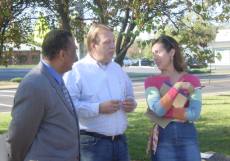SierraScape December 2005 - January 2006
Back to Table of Contents
by Janet Jump

From Left to Right: Mayor Adams, Mayor Langston and Janet Jump of the EMG Energy Committee. |
Eastern Missouri Group Sierrans had much to celebrate when they gathered on the lawn of Maplewood City Hall the morning of October 18. Sierra Club representatives, along with Missouri Coalition for the Environment, the St. Louis Community Air Project, and the U.S. Green Building Council, held a press event to thank three local mayors who have signed the U.S. Mayors' Climate Protection Agreement. The signers pledge to take an active leadership role in the fight against climate change.
The event was a milestone in a growing local campaign. Since May, hundreds of Eastern Missouri Group members have sent letters and called their mayors, asking them to sign the agreement and take action to reduce global warming pollution.
In conjunction with the mayoral recognition, the event was the St. Louis launch of the "Cool Cities" Campaign tour which highlights a variety of positive actions cities around the country are already taking to reduce global warming pollution. The Missouri tour included St. Louis, Springfield, and Kansas City.
The three local mayors honored at the event were University City Mayor Joseph Adams, Maplewood Mayor Mark Langston, and St. Louis City Mayor Francis Slay, who had signed on the week before. They joined Mayor Kay Barnes of Kansas City, MO and more than 185 other mayors nationwide.
And since our event, Mayor Robert Lowery, Sr. of Florissant has signed on as well! The U.S. Mayor's Climate Protection Agreement effort started with the mayor of Seattle, and is on the web at www.ci.seattle.wa.us/mayor/climate/.
At the press event, Mayors Langston and Adams spoke and received their certificates of appreciation from Jill Miller, Sierra Club Conservation Organizer for Missouri's Global Warming and Energy Program.
Mayor Langston, in his remarks, lauded the mayors' efforts at emissions reductions as quite simply our responsibility to the next generation. Maplewood intends to include more fuel efficient fleet vehicles, change to more economical lighting in buildings, introduce skylights, and augment the recycling programs. Hybrid vehicles, including a Mercury Mariner that is made in Missouri, were on display to remind all of the wisdom of converting city fleets and personal vehicles from gas-guzzlers to fuel-sipping hybrids.
Mayor Adams' goals for University City includes more efficient vehicle fleets as well as a commitment to build the city's new recreation center to meet LEED standards.
Erin Noble, who represents the Missouri Coalition for the Environment's Energy Action Team, highlighted other Cool Cities accomplishments. Salt Lake City is saving $32,000 a year by changing out conventional traffic signals to light emitting diode (LED) signals. Fully implemented, the changeover will eliminate over 500 tons of carbon dioxide pollution each year with cost savings of $53,000 annually.
| TAKE ACTION! |
|---|
| To get involved in the Sierra Club's exciting "Cool Cities" Campaign, see www.sierraclub.org/globalwarming/coolcities. The website includes the Cool Cities Campaign Activist Manual, including sample letters to mayors asking them to sign the U.S. Mayors' Climate Protection Agreement. It is also important to thank those mayors who have signed on. |
There are many more examples of sizeable cost savings in other cities featured in the Sierra Club's recent publication titled, "Cool Cities, Solving Global Warming One City at a Time".
Emily Andrews was on hand to represent the St. Louis Community Air Project. The Project's focus is air quality. She reminded listeners that St. Louis regularly exceeds acceptable levels of ozone and particulate matter. Currently, the Air Project is promoting an Idle-Free Schools statute that would forbid bus idling at school pickup sites.
Pat Justis of the Missouri Department of Natural Resources Energy Center spoke on the value of the green buildings. The U.S. Green Building Council works to promote environmentally responsible construction practices in both new and renovated buildings. Buildings account for 40% of total energy usage nationwide and 70% of electrical usage. Adopting the Leadership in Energy and Environmental Design (LEED) standards as laid out by the U.S. Green Building Council translates to measurable and ever-increasing savings to businesses both public and private. Public officials have a fiscal responsibility to taxpayers to build green.
Reversing global warming can seem like an insurmountable task in today's political climate. But as the committed mayors develop plans to achieve their local goals, we will see the global goals met one city at a time.